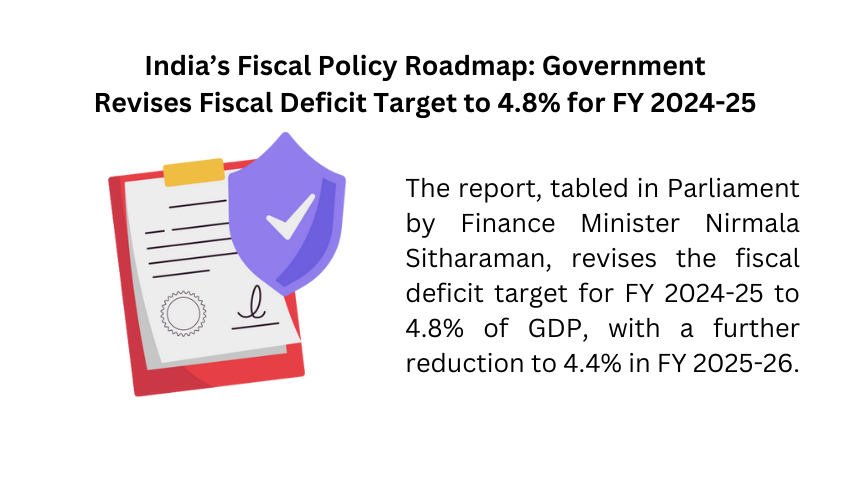New Delhi, February 2025: The Indian government has outlined its fiscal strategy for the upcoming years in its latest Fiscal Responsibility and Budget Management (FRBM) Policy Statement. The report, tabled in Parliament by Finance Minister Nirmala Sitharaman, revises the fiscal deficit target for FY 2024-25 to 4.8% of GDP, with a further reduction to 4.4% in FY 2025-26.

Macroeconomic Overview
India’s economy is projected to grow at 6.4% in real terms and 9.7% in nominal terms in FY 2024-25, as per the National Statistics Office’s first advance estimates. The services sector is expected to lead the growth at 7.2%, while agriculture and industry are projected to grow at 3.8% and 6.2%, respectively.
Inflation has moderated, with average retail inflation easing to 4.9% (April-December 2024) from 5.4% in the previous fiscal year, largely due to government interventions such as buffer stock maintenance and import relaxations.
Fiscal Deficit and Debt Management
The government remains committed to fiscal consolidation while balancing growth. The fiscal deficit for FY 2025-26 is projected at 4.4% of GDP, keeping it on track to meet the long-term goal of bringing it below 4.5% by 2025-26.
Key fiscal targets include:
- Revenue deficit: To decline from 1.9% in FY 2024-25 to 1.5% in FY 2025-26.
- Primary deficit: To fall from 1.3% to 0.8% of GDP over the same period.
- Central government debt: Expected to decline to 56.1% of GDP in FY 2025-26.
External Sector and Capital Markets
India’s merchandise exports grew by 1.6%, while services exports surged by 11.6% in April-December 2024. The current account deficit (CAD) has moderated to 1.2% of GDP, while foreign exchange reserves stand at $640.3 billion, providing an import cover of 11 months.
On the capital markets front, the total resource mobilization from primary markets (equity and debt) stood at ₹11.1 lakh crore, reflecting a 5% growth over the previous fiscal year. Demat accounts have surged by 33%, reaching 18.5 crore as of December 2024.
Revenue and Expenditure Trends
During April-December 2024, gross tax revenues increased by 10.8%, and non-tax revenue surged by 43.3%. However, capital receipts declined by 7% due to lower-than-expected recoveries.
Government expenditure rose 5.8% YoY, with a 27.6% surge in capital expenditure post the passage of the full-year budget in August 2024. Effective capital expenditure is estimated at ₹15.48 lakh crore (4.3% of GDP) in FY 2025-26, emphasizing infrastructure and growth-centric investments.
Monetary and Banking Sector Developments
The Reserve Bank of India (RBI) maintained the repo rate at 6.5%, shifting its stance from “withdrawal of accommodation” to “neutral” in October 2024. The Gross Non-Performing Assets (GNPA) ratio of banks has hit a 12-year low of 2.6%, while return on equity and return on assets have improved.
Fiscal Outlook and Path Ahead
The government has emphasized a responsible fiscal strategy, ensuring that public debt remains sustainable while prioritizing growth. Looking ahead, the new fiscal consolidation path will focus on keeping the debt-to-GDP ratio on a downward trajectory, targeting 50±1% by FY 2030-31.
With global economic uncertainty and emerging protectionism posing risks, India’s fiscal policy will continue to strike a balance between prudence and development.
This report captures key fiscal policy updates from the FRBM Policy Statement, February 2025, presented by the Ministry of Finance, Government of India. Stay tuned for more updates on India’s economic policies and budget developments.